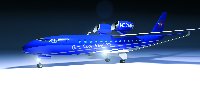Agency focuses on four areas for 'public good', including quiet supersonic demonstrator
A low-boom supersonic demonstrator is one of four projects to be pursued under a reduced, refocused aeronautics research programme unveiled by NASA in its fiscal year 2006 budget request. Flight demonstration of a zero-emissions aircraft and a 14-day duration high-altitude unmanned air vehicle are also planned.
NASA's Vehicle Systems programme has been restructured to focus narrowly on "breakthrough" technology demonstrations in the areas of environment and exploration. Spending on the programme will decline from $641 million in FY2004 to $365 million in FY2010.
"[NASA] will focus on four areas that are clearly in the public good," says Vic Lebacqz, associate administrator for aeronautics research: mitigating sonic boom; reducing aircraft noise to within the airport boundaries; eliminating pollution; and using long-endurance UAVs for scientific missions on Earth and other planets.
Each demonstration is narrowly focused on a single technology barrier, says Dr Rich Wlezian, Vehicle Systems programme manager. The low-boom demonstration will flight test a full vehicle shaped to reduce sonic boom to a level allowing supersonic flight overland. The project is a follow-on to flight tests of a modified Northrop F-5 that proved airframe shaping could produce a shaped sonic boom.
"The F-5 boom was shaped, but not mitigated," says Wlezian. "The next step is to show acceptable sonic boom." Details have yet to be decided, but NASA is looking at a sub-scale demonstrator as most cost-effective. A flight demonstration around 2010 looks likely.
The subsonic noise reduction project brings together several component demonstrations planned under the former Quiet Aircraft Technology programme, and could include full-scale flight tests of landing-gear fairings and continuous mould-line flaps to reduce noise.
NASA is still discussing what form the zero emissions demonstrator will take, says Wlezian. One option is a hydrogen-powered fuel-cell aircraft with cryogenic electric motors embedded in the wing. Another is an aircraft powered by hydrogen-fuelled turbo machinery, he says.
The 14-day duration high-altitude long-endurance remotely operated aircraft (HALE ROA) demonstration is planned as the first in a four-step programme. The HALE ROA is likely to be powered by a liquid hydrogen non-regenerative fuel-cell system, which will require development of lightweight fuel tanks, says Wlezian.
The next step would be a UAV with global range at the equator and 100-day endurance, powered by a regenerative fuel-cell system. The third would be a UAV with global range at all latitudes and the fourth a heavylifter, says Wlezian.
GRAHAM WARWICK / WASHINGTON DC

Source: Flight International























